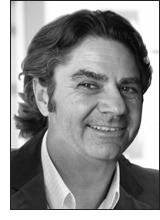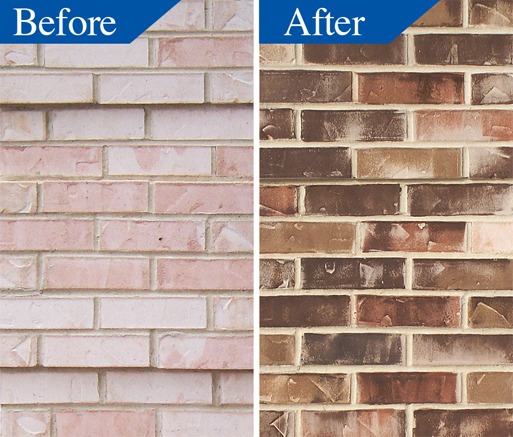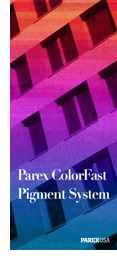The Science of Staining
Words: Dan Kamys
Mortars, Mixtures and Staining
 By Russell Gray
By Russell Gray
“The more things change, the more they stay the same.” It’s one of those puzzling expressions that make more sense once you’ve experienced it.
Staining masonry, for instance, is much the same today as it was when I stained my first building more than 40 years ago. Homeowners and property owners still choose brick for its beauty and durability. When they renovate, repair or add to their property, they want the new masonry to match – and that much will never change.
The physical act of staining masonry is much the same, too. Depending on the desired final look, most of the work is done by hand, one brick at a time, the same way they were laid. Many of the issues that gave rise to masonry staining in the first place still persist. Manufacturers face the challenges of producing consistent colors from run to run. Additions, renovations, restorations and repairs often are done with materials that don’t match, and mismatched masonry stands out like a sore thumb. This has long plagued the industry and caused many designers to choose alternate products, like EIFS (synthetic stucco), to avoid matching problems. Thankfully, staining offers the perfect solution to this age-old problem.
Many positive changes have taken place in the industry, however. Now that thousands of masonry buildings have had successful color modifications with stain, architects and general contractors are confident of the outcomes – so much so, that masonry stains commonly are specified on projects around the world. But the really exciting thing is how science is changing the stains themselves.

Today, the best companies offer multiple types of stains, since no two jobs are the same. A one-kind-fits-all approach to staining is bound to yield poor results. True staining professionals will evaluate your masonry before recommending a particular stain. For example, lithium-based stains are ideal for concrete masonry, because they provide added benefits like greater penetration and chemical bonding. This makes the surface harder and less absorbent. Or, think about stains that reduce energy costs by decreasing thermal transfer, since they reflect infrared light. I love to watch architects’ eyes light up when I talk about these.
| Product Spotlight
Parex ColorFast Pigment System |
 As a subsidiary of the Parex Group, a specialty chemicals and ready-to-use mortars company, Parex now has access to universal color a proven pigment system used globally by its sister companies. Parex offers a proprietary new pigment system that increases the range of color options, creating a broader spectrum of more vibrant, brilliant colors.
To avoid unsightly fading issues, the advanced technology of the ColorFast Pigment System incorporates an inorganic blend of high-quality pigments. Discerning architects, builders and owners can specify vivid colors with superior fade resistance for their premier structures.
The Parex ColorFast system is designed to offer color retention, and maintenance costs are reduced, due to decreased repainting schedules. The technology behind the ColorFast system allows architects to specify virtually any color, without worrying about fading or long-term maintenance.
The new ColorFast System integrates 16 unique pigments, offering a broader range of brighter colors with superior durability, increased fade resistance and improved opacity. Custom color matching also is available. ColorFast pigments are formulated with the environment in mind. All ColorFast pigments are VOC and APEO-Free. For more information, email technicalservices@parexusa.com. As a subsidiary of the Parex Group, a specialty chemicals and ready-to-use mortars company, Parex now has access to universal color a proven pigment system used globally by its sister companies. Parex offers a proprietary new pigment system that increases the range of color options, creating a broader spectrum of more vibrant, brilliant colors.
To avoid unsightly fading issues, the advanced technology of the ColorFast Pigment System incorporates an inorganic blend of high-quality pigments. Discerning architects, builders and owners can specify vivid colors with superior fade resistance for their premier structures.
The Parex ColorFast system is designed to offer color retention, and maintenance costs are reduced, due to decreased repainting schedules. The technology behind the ColorFast system allows architects to specify virtually any color, without worrying about fading or long-term maintenance.
The new ColorFast System integrates 16 unique pigments, offering a broader range of brighter colors with superior durability, increased fade resistance and improved opacity. Custom color matching also is available. ColorFast pigments are formulated with the environment in mind. All ColorFast pigments are VOC and APEO-Free. For more information, email technicalservices@parexusa.com. |
Ready for more science? Top-quality stains incorporate up to 20 percent recycled materials, which not only qualifies them for LEED points, but actually makes finishes and masonry harder and more durable. I hope you can sense my excitement as I talk about these products, because it means masonry will continue to be the building material of choice. And, masonry buildings will perform better and be even more beautiful in the future.
Masonry staining has proven to be a cost-effective solution for a variety of reasons. It’s not uncommon for my crews to take on building with more than one-half million bricks. When you change the color of a building that large, you’re really impacting the community where the building is located. Few things are more satisfying than hearing clients exclaim that they “don’t know why they didn’t do this sooner.”
I’d like to close with this thought: Masonry is still an art, and one of the most powerful tools a masonry artist has is color. Superior stain technologies offer an endless variety of color options, while providing excellent performance and great value. Of course, not all stains are created equally. The product you select for your project is as critical as the company you choose to apply it. When you’re ready to have color applied to a building, be sure and select a knowledgeable company that has a track record of standing behind the work and uses the right product for your project.
Your best bet is a company that manufactures and applies its own stains. Companies that use off-the-shelf paints, ancient technology or import products from overseas may leave you high and dry, if there’s a problem. Also, carefully read the product warranty. You’ll want a transferable product warranty, not one of these “as long as you own the property” deals. Run as fast as you can from those.
Once you see what can be achieved with today’s stains, it will create more opportunities to sell, install and design with masonry.
Return to Table of Contents